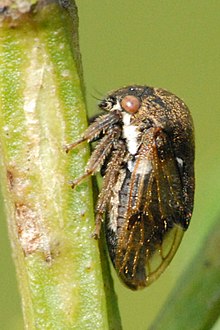Humpback chirps
| Humpback chirps | ||||||||||||
|---|---|---|---|---|---|---|---|---|---|---|---|---|

Green leaf hoppers ( Centrotus cornutus ) |
||||||||||||
| Systematics | ||||||||||||
|
||||||||||||
| Scientific name | ||||||||||||
| Membracidae | ||||||||||||
| Rafinesque , 1815 |

Humpback chirps or humpback clippers (Membracidae), engl. "Treehoppers", are a family from the superfamily of the Membracoidea within the suborder of the round-headed cicadas (Cicadomorpha). They are particularly widespread in the tropics, where they are very rich in species and forms. The sometimes highly complicated processes of the pronotum (pronotum) of these insects are characteristic . Over 3,200 species from over 400 genera have been described worldwide. The existence of up to 10,000 species is assumed.
description
Humpback chirps are relatively large species with a steeply tilted head. They have particularly bizarre shapes by various, very complex part and sweeping extensions of the neck shield on (pronotum), some of which exceed the body in size. Despite these prominent extensions, the typical roof-like wing posture of the cicadas remains clearly recognizable.
Way of life
Humpback chirps live on various plants and suckle phloem . They use the high sugar content of the plant sap, whereby the excess sugar is excreted by the animals. In some species, these excretions are ingested by ants with which the chirps are associated.
Some species specialize in certain host plants; some can be harmful.
Since the food does not contain essential amino acids, the chirps need endosymbiotic bacteria, which can be found in bacteriomas in the abdomen. These have only been studied in a few species, but are likely to be common in most cicadas.
Systematics
The humpback chirps are divided into 9 subfamilies, usually with several tribes: Centronodinae, Centrotinae, Darninae, Endoiastinae, Heteronotinae, Membracinae, Nicomiinae, Smiliinae and Stegaspidinae. Practically all of the subfamilies except the Centrotinae are restricted to the Neotropis . The large subfamily of the Centrotinae has 6 tribes in the New World and 17 tribes in the Old World. The neotropical buffalo cicada, which belongs to the Smiliinae, has been introduced into large parts of the Palearctic .
In Europe there are five species in four genera from two subfamilies: the thorn cicada ( Centrotus cornutus ) occurring in Central Europe including Germany, the gorse cicada ( Gargara genistae ) and the buffalo cicada ( Stictocephala bisonia ) as well as the Oxyrhachis capeneri and Centrotus chloroticus, which are exclusively native to the Mediterranean area .
Subfamilies, genera and species in Europe:
-
Centrotinae
Amyot & Serville , 1843
-
Centrotus Fabricius , 1803
- Red leaf hoppers ( Centrotus cornutus ( Linnaeus , 1758))
- Centrotus chloroticus Fairmaire , 1851
-
Gargara Amyot & Serville , 1843
- Gorse cicada ( Gargara genistae ( Fabricius , 1775))
-
Oxyrhachis Germar , 1833
- Oxyrhachis capeneri Izzard , 1953
-
Centrotus Fabricius , 1803
-
Smiliinae Stål , 1866
- Stictocephala Stål , 1869
Genera outside of Europe (selection) , sorted by subfamily:
- Centrotinae
- Darninae
- Heteronotinae
- Membracinae
- Nicomiinae
- Smiliinae
- Stegaspindinae
swell
literature
- R. Biedermann, R. Niedringhaus: The cicadas of Germany - identification tables for all kinds . Fründ, Scheeßel 2004, ISBN 3-00-012806-9
- C. Godoy, X. Miranda, K. Nishida: Membrácidos de la América Tropical / Treehoppers of Tropical America . Santo Domingo de Heredia: INBIO, Inst. Nacional de Biodiversidad, 2006, ISBN 9968-927-10-4
- WE Holzinger, I. Kammerlander, H. Nickel: The Auchenorrhyncha of Central Europe - Die Zikaden Mitteleuropas. Volume 1: Fulgoromorpha, Cicadomorpha excl. Cicadellidae. - Brill, Leiden 2003, ISBN 90-04-12895-6
- H. Nickel: The leafhoppers and planthoppers of Germany (Hemiptera, Auchenorrhyncha): Patterns and strategies in a highly diverse group of phytophagous insects. Pensoft, Sofia and Moscow, 2003, ISBN 954-642-169-3
- H. Nickel, R. Remane: List of species of cicadas in Germany, with information on nutrient plants, food breadth, life cycle, area and endangerment (Hemiptera, Fulgoromorpha et Cicadomorpha). - Contributions to the cicada 5/2002. pdf 229 KB
- R. Remane, E. Wachmann : Cicadas - get to know, observe - Naturbuch Verlag, Augsburg 1993, ISBN 3-89440-044-7
Individual evidence
The following sources are cited for individual aspects:
- ↑ Masterful: How evolution became a large sculptor , in: FAZ of May 11, 2011, page N1
- ↑ M. Mao, X. Yang, K. Poff, G. Bennett: Comprative genomics of the dual-obligate symbionts from the treehopper, Entylia carinata (Hemiptera: Membracidae), provide insight into the origins and evolution of ancient symbiosis . In: Genome Biol. Evol. tape 9 , no. 6 , 2017, p. 1803-1815 , doi : 10.1093 / gbe / evx134 .
- ^ Deitz, LL, and MS Wallace (team leaders) .: TREEHOPPERS. 2010, accessed November 9, 2016 .
- ↑ a b Membracidae in Fauna Europaea , as of March 2, 2015.
- ↑ a b Herbert Nickel and Reinhard Remane: List of species of cicadas in Germany, with information on nutrient plants, food breadth, life cycle, area and endangerment (Hemiptera, Fulgoromorpha et Cicadomorpha). Contributions to the cicada, 5, pp. 27–64, 2002 full text (PDF, German; 234 kB)
- ↑ a b W.E. Holzinger: Preliminary list of the cicadas of Central Europe (Insecta: Hemiptera: Fulgoromorpha et Cicadomorpha); Preliminary checklist of the Auchenorrhyncha (leafhoppers, planthoppers, froghoppers, treehoppers, cicadas) of Central Europe. , Status 2003 ( PDF , accessed on February 18, 2017.)
Web links
- Website about humpback cicadas with many pictures, references and information on distribution and systematics (English) [1]
- Photos in GEO magazine
- Photos of humpback hoppers (Membracidae) of Central Europe


